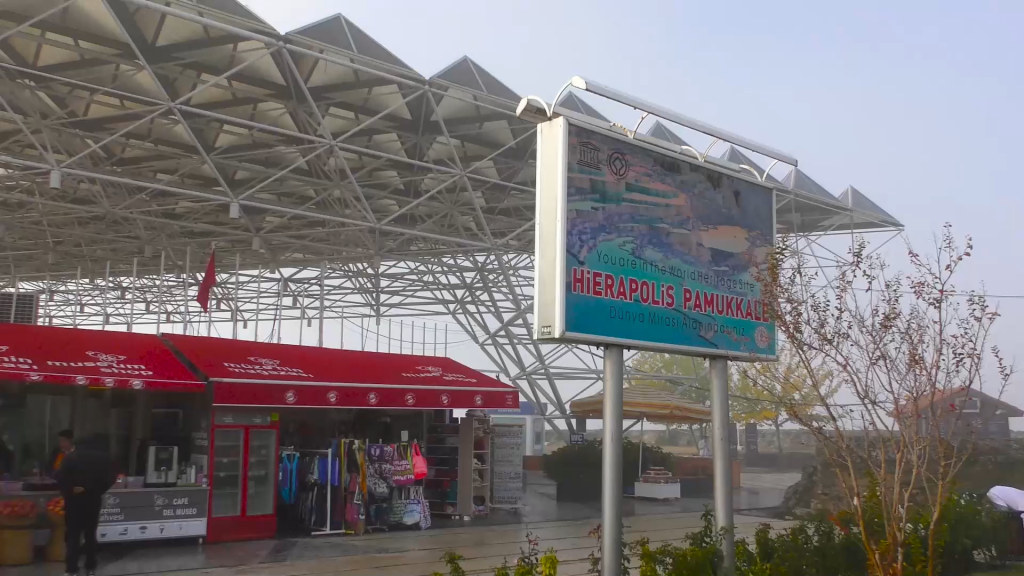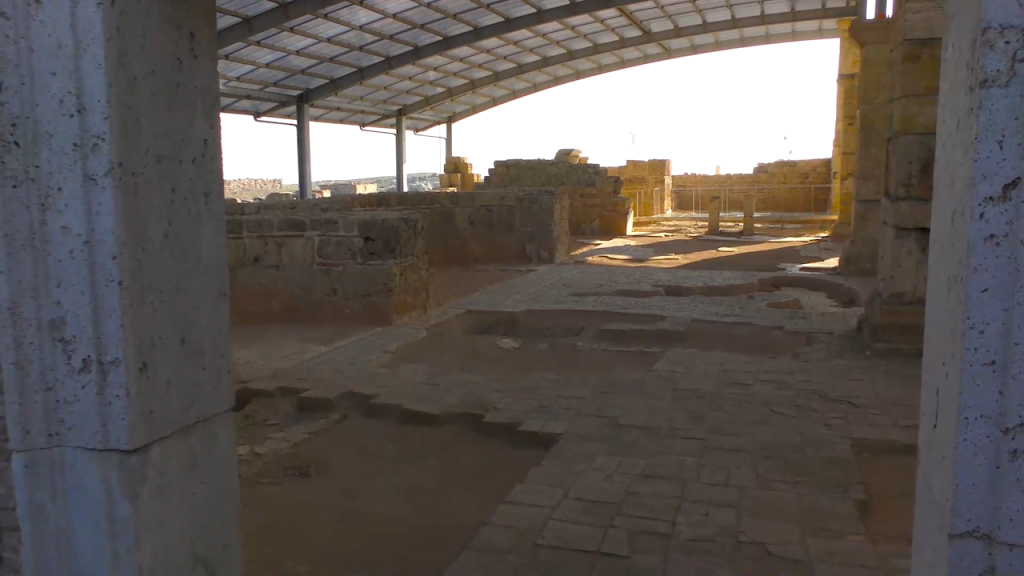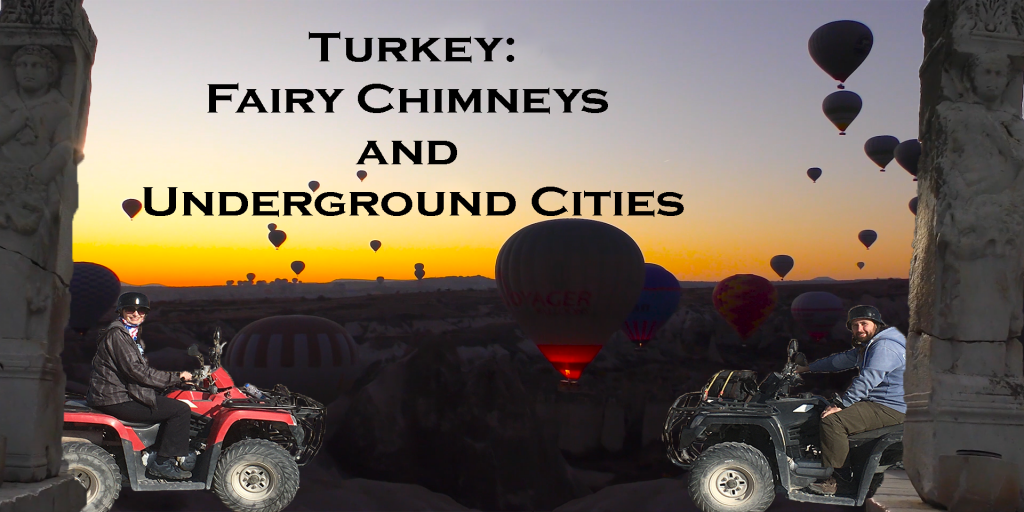Laodicea on the Lycus
A blog post by Greg
We got to visit several historical sites during our travels in Turkey. The Underground Cities and Fairy Chimneys of Cappadocia, and the Ancient Greek ruins of Hierapolis and Ephesus, as well as St John’s Basilica and the ruins of the Temple of Artemis, one of the ‘Seven Wonders of the Ancient World’.
Watch ‘Turkey: Fairy Chimneys and Underground Cities’ – Free on Plex
Of all the sites which we visited, however, none had quite the same impact on me as Laodicea on the Lycus in Denizli, and it was one of those wonderful moments which travelling presents where we nearly never saw it at all, and a last-minute decision led to a very special experience.
I ought to point out, from the start, that we took this visit in late 2019, and so I don’t know as I write this at the start of 2022 how much the site has changed from what we saw. I mention this because it was very much the point in time at which we visited Laodicea that made the visit so special.
Part of my interest in history, and historical sites around the world, comes from a class in primary school. One day we sat down to a history lesson, and we were in the heart of studying the Ancient Egyptians. Of course, we had already learned about building the pyramids, about mummification and the River Nile, but the story we were to learn about in that lesson was more important to me than any other I can remember hearing in a history lesson throughout my time in school.
In 1922 Howard Carter discovered the tomb of the pharaoh Tutankhamun in the Valley of the Kings. The story of the discovery and excavation of the tomb (which perhaps I will go into in another blog post in the future), and the ‘wonderful things’ which his team discovered, combined with watching Indiana Jones, inspired my interest in history, and a desire to visit ancient sites around the world.
The day before we visited Laodicea we had spent a day looking around Hierapolis and the Cotton Castles of Pamukkale. The ancient city of Hierapolis is amazing, and so much of it has been restored to give a good idea of how it would have appeared back when it was inhabited. It is also a tourist centre, with gift shops and kiosks throughout the site, and museum buildings and displays filled with information. It is a wonderful site to go and visit as part of a trip to the area.

After our trip to Hierapolis our plan had been to get up the next morning and make the drive to Izmir ready to visit Ephesus and the Temple of Artemis, but looking at the map we had time to visit another site on our way. The hotel had provided us with a welcome pack with ‘things to do in the local area’, and Laodicea was one of several ruins listed. I’m not sure what made us pick that one above the others, but I’m glad we did!
Laodicea on the Lycus, is something completely different from what we had seen at Hierapolis, which we realised as we drove up a small road towards the entrance to the site, stopping briefly at a security checkpoint where mirrors on sticks were used to check underneath our car, security sadly needed due to the importance of the site to Christian people (it was one of seven churches that Jesus tells John to write a message to in the Book of Revelation in the Bible – more on that later) putting it at increased risk of terrorist incidents.
Arriving at the carpark, which is just an open area beside a small ticket office with a few souvenirs for sale, we found only a couple more cars there, compared with several buses which had been arriving at Hierapolis at the same time as us the day before, and as we looked around Laodicea it didn’t get much busier. To one side of the carpark there were a couple of signs giving information about the site.
The city was first built (and I say first built as it was destroyed by earthquakes several times, as I discovered to my slight confusion from the sign at the entrance to the car park) in around about 260BC, although there is evidence of people living in the area three thousand years earlier than that as flint and obsidian tools have been discovered from that time.
According to the sign I read at the city (as shown in the clip above from ‘Turkey: Fairy Chimneys and Underground Cities), the city was abandoned after a ‘devastating earthquake’ at the start of the 7th Century AD, meaning that as a city it stood for just under nine hundred years. This is contested, as Byzantine sources mention it throughout the 11th and 12th Centuries, and have it finally being abandoned in the 13th Century. Which of these is correct will, I’m sure, only be confirmed through further research and study of finds on the site.
This is, in a way, the entire point of this blog, and what I enjoyed most about our visit to Laodicea. It is, currently, a working excavation! They seem to be planning to one day make it a big tourist site like Hierapolis, and it will be an amazing place to visit, but right now it is history in progress! There is a team working there who are uncovering new finds, and also seeking to restore a lot of the site. They were excited about their work and (although we had to leave the camera switched off) took us into the area which they were currently working on, and, despite the language barrier, tried to show us everything that they were discovering and uncovering in that building. Imagine going to any major historic site you have ever visited, but being there as it is being worked on, meeting the people carrying out the excavations.
In a few years this will be a major tourist site. They are restoring it in a big way and there are some amazing sites there – in fact, we even got to see some of the processes of restoring a beautiful theatre, moving large rocks in wheelbarrows on cranes as they try to get the right pieces back in the right places, as you can see in this footage below from ‘Turkey: Fairy Chimneys and Underground Cities’.
One of the reasons why I’m sure that it will become a major tourist site once it has been restored (as well as the scale and quality of the site, of course), is its connection to the Book of Revelation in The Bible, and the fact that it is mentioned multiple times in the book. Religious travellers and pilgrims already head to St John’s Basilica near Ephesus, a little over a hundred miles from Laodicea. St John wrote the Book of Revelation, which includes seven letters to churches in the area which Christians believe were written by St John at Jesus’ request. One of these was the church at Ephesus, and another the church at Laodicea, and so it is fair to assume that when Laodicea is complete as a tourist site that it will join Ephesus as a centre of religious travel.
This is interesting, because in 363AD a council of clerics from across Asia Minor gathered at Laodicea, presumably in the church which was discovered by radar in 2010, and opened to the public in a restored state in 2016.

This council was to decide on a number of issues of church doctrine, and finished up with 60 canons, rules for the followers of the churches involved. Among these canons, canon 59 and 60 deal with The Bible itself. Canon 59 made it forbidden to read any of the books of The Bible which the council decreed ‘uncanonical’, any of the books which featured in some versions of the Bible at that time, or in some teachings, which they decided were not to be part of the ‘official’ Bible going forwards.
It may come as a surprise to some (I know it did to me when I first discovered it in my late teens) that The Bible as we know it is the product of debates and agreements over hundreds of years, and during that time books were added and removed from the ‘canonical’ version of various churches until the ‘modern’ versions of The Bible came into being (and even then there are some differences in which books are contained depending on the denomination!).
At the Council of Laodicea, the canonical books of The Bible were listed in Canon 60, and included most of the books which would be recognised in The Bible today, with one notable exception. The Book of Revelation was not included in the canonical Bible agreed at the Council of Laodicea, that book which had the main mention of both the city and its church. There could be many reasons for this. Perhaps it was decided that the book was too different in style from the remainder of the books, perhaps they raised questions about its authenticity or its holy provenance.
Personally, I can’t help thinking that it may have been left out because of what it said about the Church of Laodicea. That’s right, I’m about to quote scripture!
Today’s reading comes from the Book of Revelation, chapter three, verses 14-18:
“To the angel of the church in Laodicea write:
These are the words of the Amen, the faithful and true witness, the ruler of God’s creation. 15 I know your deeds, that you are neither cold nor hot. I wish you were either one or the other! 16 So, because you are lukewarm—neither hot nor cold—I am about to spit you out of my mouth. 17 You say, ‘I am rich; I have acquired wealth and do not need a thing.’ But you do not realize that you are wretched, pitiful, poor, blind and naked. 18 I counsel you to buy from me gold refined in the fire, so you can become rich, and white clothes to wear, so you can cover your shameful nakedness; and salve to put on your eyes, so you can see.
I can’t help thinking that if I were sat at the Council of Laodicea, in the Church of Laodicea, and I found that one of the books which we were considering making canonical called the people of Laodicea wretched, pitiful, poor, naked – and not just naked but shamefully naked – then perhaps I might decide that particular book might be left out!
This is, of course, pure conjecture on my part based on human nature – Biblical scholars are more than welcome to disagree!
Whatever draws people to Laodicea some years in the future when work is complete, I am sure that they are going to find an example of an ancient Greek and Roman city which will be incredible to look around. I am, however, glad that we visited at this stage. Yes, not everything has been uncovered yet, and yes a large part of the site is shielded from view where it is being worked on (unless you are lucky enough to be invited in by the team working there). If you get a chance to go and see it while it is still in the excavation stage, however, I would very strongly recommend it – the chance to see a site of this scale and quality in mid-excavation is not one you are going to have too many chances to experience!
We are always looking for incredible ancient sites to visit while on our travels – so please leave a comment below to let us know where the best sites you have ever visited are!
Thank you for reading, and please take unbelievably good care of yourselves, and of each other!
Greg
P.S.
If you enjoyed this blog post, please leave a comment and say ‘hello’!
For information on all of our projects, visit: www.gregandfelicityadventures.com
Follow us on Instagram at: https://www.instagram.com/gregandfelicity
Like us on Facebook at: https://www.facebook.com/GregandFelicityAdventures
There are various places you can watch our documentaries and series!
Seeking Cetaceans In Scotland: A two-part documentary about the work of the Cetacean Research and Rescue Unit as they work to help whales, dolphins and porpoises in the Moray Firth in Scotland:
Free in the USA on Tubi TV at:
https://tubitv.com/movies/678018/seeking-cetaceans-in-scotland
Free Worldwide on PlexTV at:
https://watch.plex.tv/movie/seeking-cetaceans-in-scotland
With a library card on the Hoopla service where applicable:
https://www.hoopladigital.com/title/15313766
Free in the USA on Xumo at:
https://www.xumo.tv/channel/99991731/free-documentaries?v=XM00ILOFXCKLUC&p=74071
Buy it without ads Amazon’s Prime Video at:
UK: https://www.amazon.co.uk/dp/B09RVWVFCV
USA: https://www.amazon.com/dp/B09RVWJGY1
(Greg and Felicity are donating half of our streaming income on this documentary to support the CRRU).
Available to buy on DVD (with £5 from each donated to the charity): https://ko-fi.com/s/73e469d114
ROMANIA: SEEKING DRACULA’S CASTLE: Our travel documentary looking into the history, legend and castles connected to Vlad Dracula III, sometimes known as Vlad the Impaler, and a journey around Romania:
Free Worldwide on Plex: https://watch.plex.tv/movie/romania-seeking-draculas-castle
Free (USA) on Tubi: https://tubitv.com/movies/579192/romania-seeking-dracula-s-castle
Prime Video (From £1.99, no Ads) (UK): https://www.amazon.co.uk//dp/B08RDPZP14
Prime Video (From $1.99, no Ads) (USA): https://www.amazon.com/dp/B08RDJR4F2
TURKEY: FAIRY CHIMNEYS AND UNDERGROUND CITIES: A travel documentary across Turkey, from the Fairy Chimneys and Underground Cities of Cappadocia to the ancient Greek ruins of Ephesus and Hierapolis:
Prime Video UK (From £2.49, no Ads): https://www.amazon.co.uk/Turkey-Fairy-Chimneys-Underground-Cities/dp/B09KKSZLRW
Prime Video USA (From $1.99, no Ads): https://www.amazon.com/Turkey-Fairy-Chimneys-Underground-Cities/dp/B09KK6VDJB
Free Worldwide on Plex: https://watch.plex.tv/movie/turkey-fairy-chimneys-and-underground-cities
Free (USA) on Tubi: https://tubitv.com/movies/579225/turkey-fairy-chimneys-and-underground-cities
Greg Chapman’s Magic Show: An eight-part series of magic and entertainment with Greg:
Free in the USA on Tubi at: https://tubitv.com/series/300008713/greg-chapman-s-magic-show
Free worldwide on Plex: https://watch.plex.tv/show/greg-chapmans-magic-show/season/1
Available to buy on DVD: https://ko-fi.com/s/7c1bc10a08
Mexico: Mayan Mystery and Marine Majesty: Filmed on our honeymoon in Mexico in 2019, our first travel documentary took us through the ancient sites of Teotihuacan, Uxmal, El Tajin, Palenque, Chichen Itza and Calakmul, and then on to see the whales of Magdalena Bay, whale sharks of La Paz, and more.
Watch free on YouTube: https://youtu.be/yfMpD868MHU
The Isle of Man: Railways, Castles and Seals: Our second travel documentary took us to the Isle of Man!
Watch free on YouTube: https://youtu.be/uCpUa6XEkbg

2 thoughts on “Laodicea on the Lycus”